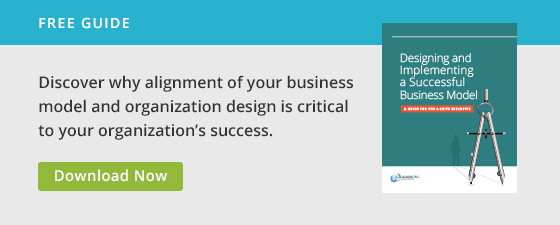How do I optimize my resources? It is the perennial question for today’s businesses. Our philosophy is that aligned organizations can better optimize their resources to create both great efficiencies as well as desired growth. To accomplish both of these objectives, businesses must consider a more holistic approach to organization design that aligns the entire organizational system from the strategy phase of the work all the way through implementation.
Phase 1: Strategy
To better understand what a more holistic organization design looks like, imagine that the organization design process is divided into three main areas or phases: strategy, organization design/alignment, and implementation. In the first area, the leadership team develops a strategy that will provide a competitive advantage for the company in the marketplace. While the actual strategy does play an important role for the overall success of the design, perhaps equally significant is the degree alignment leaders can achieve in the process. I have seen many organizations with a less than perfect strategy outperform organizations with a superior strategy because their leadership team was better aligned and in the end, aligned leaders move faster and make choices that will lead to a virtuous cycle of increasing growth and efficiency.
Phase 2: Organization Design/Alignment
The emphasis on alignment carries over into the organization phase of a design as well. A well-aligned design considers all aspects of a business such as work, structure, information, culture, people/rewards, metrics, etc. before making changes. This focus on the entire, interconnected system helps leaders truly align the entire organization around the strategy and the desired outcomes.
The byproduct and power of this approach is increased organizational focus. A focused organization exploits areas of the business have the most strategic value and will align performance around that value. The value may be a seamless customer experience, a single-point-of-contact structure, or sales incentives that better support clients. Regardless, creating a focus on the capabilities that drive your organization allows you to invest your resources and energies in the right direction. In this way, every dollar you spend goes further since it is being used for the areas that will produce the best return for your organization.
We often talk about strategic capabilities like muscles. If you focus on a muscle and exercise it in the right way, it will grow stronger. However, for many companies it can be difficult to identify the right muscle for the market. A few years ago, we were working with a health insurance company functioning in a largely cost-driven market. Through our involvement, the company developed a disruptive model that not only competed on cost but also included a set of analytical tools for members that helped them adopt healthier lifestyles. In other words, the health insurer was not necessarily the cheapest, but they provided methods for members to manage their health and by extension lower the overall cost in the long term.
Even though, as a firm, we are not subject matter experts in the health insurance field, our methodology asked important questions that helped this company identify the strategic muscles they needed. The result was that they were able to identify a value that their competitors didn’t have and were able to disrupt the market and increase their market share. Helping the company identify, align, and ultimately focus on the right value led to investing their resources in a way that created marketplace success.
In a similar vein, focus and alignment means that businesses consciously choose not to invest in certain aspects of their organizations. To free up resources, alignment demands that companies identify non-differentiating areas of the business and divert some of those resources to the areas about which customers care more. This does not mean that these less strategic areas or activities are unnecessary, but rather are opportunities for diverting resources to other more strategic areas of the business in order to maximize returns.
Phase 3: Implementation
Consciously choosing where to utilize resources also affects the implementation phase of the work. Implementation efforts such as change management, communications, and detailed process design can take time. However, by improving organization alignment and focusing on the areas of your business with the most strategic value, you can increase the speed of your implementation. If the leadership team is aligned from the strategy phase of the work, it will also be easier to cascade a consistent message throughout the organization.
Additionally, alignment prior to and through the implementation phase also helps easily identify the places in the organization that will experience the most change. As a result, change agents will know the areas that will need the most attention and resources during implementation efforts and can plan accordingly. In essence, the focus created through alignment helps divide and prioritize the work into manageable pieces with clear steps to follow.
Overall, organization alignment should play a major part in every aspect of an organization design from strategy to implementation. It allows businesses to both grow and become more efficient as they focus efforts and resources on activities that lead to market disruption and success. Through more practical understanding and approach to organization design, companies can ultimately optimize their resources leading to greater focus, faster implementation speed, and more marketplace success.

